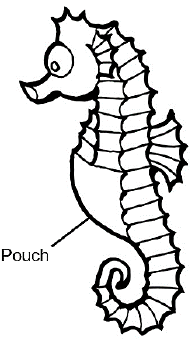Life Sciences Paper 1 Questions - Grade 12 September 2021 Preparatory Exams
Share via Whatsapp Join our WhatsApp Group Join our Telegram GroupINSTRUCTIONS AND INFORMATION
Read the following instructions carefully before answering the questions.
- Answer ALL the questions.
- Write ALL the answers in your ANSWER BOOK.
- Start the answer to EACH question at the top of a NEW page.
- Number the answers correctly according to the numbering system used in this question paper.
- Present your answers according to the instructions of each question.
- Do ALL drawings in pencil and label them in blue or black ink.
- Draw diagrams, tables or flow charts only when asked to do so.
- The diagrams in this question paper are NOT necessarily drawn to scale.
- Do NOT use graph paper.
- You may use a non-programmable calculator, protractor and a compass where necessary.
- Write neatly and legibly.
QUESTIONS
SECTION A
QUESTION 1
1.1 Various options are provided as possible answers to the following questions. Choose the answer and write only the letter (A–D) next to the question numbers (1.1.1 to 1.1.10) in the ANSWER BOOK, for example 1.1.11 D.
1.1.1 The part of the brain that regulates the carbon dioxide concentration in the human body:
- Hypothalamus
- Cerebrum
- Cerebellum
- Medulla oblongata
1.1.2 The energy needed for the movement of a sperm is produced in the …
- mitochondria.
- nucleus.
- acrosome
- ribosome.
1.1.3 Which ONE of the following hormones stimulates puberty in females?
- LH/Luteinising hormone
- Oestrogen
- FSH/Follicle stimulating hormone
- Prolactin
1.1.4 Ovulation is the release of …
- an ovum into the fallopian tubes.
- mature graafian follicles into the uterus.
- corpus luteum into the fallopian tubes.
- an ovum into the uterus.
1.1.5 Which ONE of the following structures contains photoreceptors?
- Retina
- Choriod
- Vitreous humor
- Pupil
1.1.6 The synapse is a microscopic gap between a/an …
- cell body and the axon of one neuron.
- receptor and effector.
- axon of one neuron and the dendrite of another neuron.
- axon of one neuron and the axon of another neuron.
1.1.7 The myelin sheath …
- prevents dehydration of the axons.
- provides energy for the transmission of impulse.
- provides electrical insulation.
- maintains a lower temperature.
1.1.8 A man lost his memory after a car accident.
Which ONE of the following parts of the brain might have been damaged in the accident?
- Cerebrum
- Cerebellum
- Medulla oblongata
- Corpus callosum
1.1.9 A list of possible visual effects is given below.
- Unable to receive a wide field of view.
- Unable to distinguish between red and green colours.
- Unable to read a book under bright light.
- Unable to register a sense of three-dimensional shape and form from visual inputs/perceive the depth of an object on 3D.
Which ONE of the following combinations will occur when a person has lost one eye in an accident?
- (i), (ii) and (iii) only
- (i), (iii) and (iv) only
- (i) and (iv) only
- (ii), (iii) and (iv) only
1.1.10 A high concentration of adrenalin in the blood leads to an increase in blood glucose levels, because …
- glycogen in the liver and muscles is converted to glucose.
- proteins are broken down to release more glucose.
- there is a decrease in metabolic rate.
- there is an increase in the digestion of carbohydrates. (10 x 2) (20)
1.2 Give the correct biological term for each of the following descriptions. Write only the term next to the question numbers (1.2.1–1.2.8) in the ANSWER BOOK.
1.2.1 The collective name for the membranes that protect the brain
1.2.2 The branch of the nervous system that consists of the cranial and spinal nerves
1.2.3 The branched outgrowth of a neuron that transmits nerve impulses to the cell body of the same neuron
1.2.4 The plant growth movement in response to gravity
1.2.5 The structure in the ear that absorbs excess pressure waves from the inner ear
1.2.6 The hormone that stimulates an increase in the rate of metabolism in the cells
1.2.7 The gland that secretes aldosterone
1.2.8 A structure in a female reproductive system where semen is deposited (8 x 1) (8)
1.3 Indicate whether each of the descriptions in COLUMN I apply to A ONLY, B ONLY, BOTH A AND B or NONE of the items in COLUMN II. Write A only, B only, both A and B or none, next to the question numbers (1.3.1 to 1.3.3) in the ANSWER BOOK.
| COLUMN I | COLUMN II | |||
1.3.1 | A type of gland whose secretions are transported in ducts/tubes to a target organ | A: B: | Endocrine gland Exocrine gland | |
1.3.2 | A symptom of Alzheimer’s disease | A: B: | Memory loss Confusion | |
1.3.3 | A type of lens used to correct short-sightedness (myopia) | A: B: | Biconvex lens Biconcave lens | |
(3 x 2) (6)
1.4 The diagram below represents a reflex arc.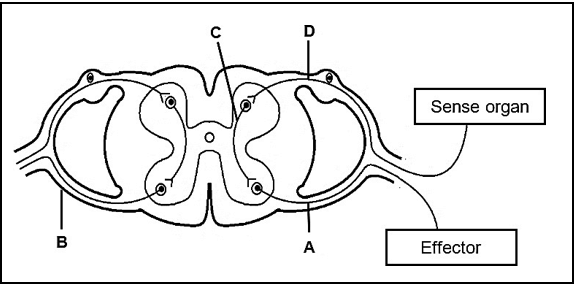
1.4.1 Write down, in the correct sequence, the LETTERS representing the neurons that transmit impulses to the effector. (2)
1.4.2 State the significance of a reflex action. (1)
1.4.3 Give ONE example of an effector in a human body. (1)
1.4.4 Write down the LETTER and the NAME of the:
- Neuron located only in the brain or spinal cord (2)
- Part that represents a root of the spinal nerve (2)
- Neuron that is damaged when a person feels pain, but is unable to react (2)
1.5 The diagram below shows some endocrine glands in a male body.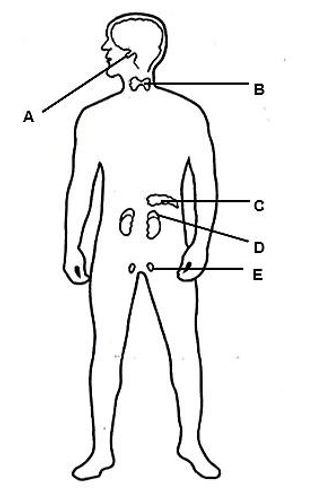
1.5.1 Identify gland:
- B (1)
- E (1)
1.5.2 Name the:
- Gland that secretes growth hormone (1)
- Hormone that stimulates gland B (1)
- Gland that secretes adrenalin (1)
1.5.3 Give the LETTER of the gland that secretes a hormone responsible for stimulating the reabsorption of water by kidney tubules. (1)
TOTAL SECTION A: 50
SECTION B
QUESTION 2
2.1 Read the extract below about reproduction in seahorses.
Male seahorses have a pocket-like structure on their abdomens called a pouch. During a mating ritual, the female seahorse deposits a large number of eggs into the pouch using a structure called an ovipositor. The male then releases many sperm into the pouch to fertilise the eggs. The developing embryos in the male pouch, are nourished by the yolk of the eggs. A fluid that is secreted within the pouch removes waste products and supplies the fertilised eggs with oxygen. The young are born alive when they are released from the pouch.
|
2.1.1 State the type of fertilisation that takes place in seahorses. (1)
2.1.2 Give a reason for your answer to QUESTION 2.1.1. (1)
2.1.3 Explain TWO ways by which the seahorses increase their reproductive success. (4)
2.1.4 State ONE difference between the reproductive strategy displayed by the seahorses and vivipary. (2)
2.2 In pregnant female rats, progesterone is mainly secreted by the corpus luteum. It takes about 22 days for the rat to give birth after fertilisation.
Scientists did an investigation to determine the amount of progesterone needed for the successful completion of gestation in rats.
The procedure was as follows:
- 100 female rats of the same age were selected
- They were divided into five equal groups
- All the 100 female rats were artificially inseminated at the laboratory (the sperm were inserted into the female reproductive tract using a syringe so that fertilisation can take place)
- Ovaries of each rat were removed immediately after becoming pregnant
- Group 1 was given no progesterone injection
- Group 2 was given a daily injection of 5 mg progesterone
- Group 3 was given a daily injection of 10 mg progesterone
- Group 4 was given a daily injection of 15 mg progesterone
- Group 5 was given a daily injection of 20 mg progesterone
- The number of rats who completed gestation by each group was counted and the percentage calculated
2.2.1 Define the term gestation. (2)
2.2.2 How long is the gestation period of rats? (1)
2.2.3 Identify the independent variable in this investigation. (1)
2.2.4 State TWO factors that should have been kept constant during the investigation. (2)
2.2.5 Explain why the ovaries were removed immediately after the rats were pregnant. (3)
2.2.6 Describe how the percentage of rats who completed gestation was calculated. (2)
2.2.7 Explain why Group 1 was included in the investigation. (2)
2.3 The diagram below shows the structure of the human eye.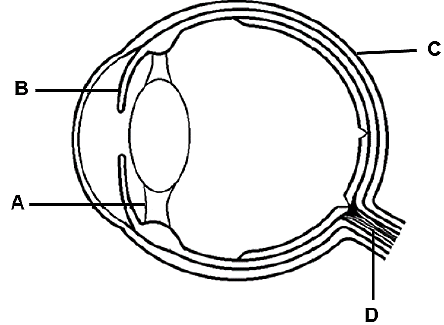
2.3.1 Identify the parts labelled:
- A (1)
- B (1)
2.3.2 State ONE function of part C. (1)
2.3.3 Describe accommodation of the eye when a person focuses on an object that is moving away. (4)
2.3.4 Explain the consequence that a damage to part D has on the vision of a person. (3)
2.4 2.4.1 Define homeostasis. (2)
2.4.2 A man jumped into icy cold sea water. His body temperature was maintained through homeostasis. Describe the role of the skin in thermoregulation during this time. (7)
2.4.3 When a person is exposed to very cold temperatures, the body loses more heat than it can produce. Explain why a prolonged exposure to very cold temperatures without protection may lead to death. (3)
2.5 The diagram below represents the male reproductive system, following a surgical procedure to prevent pregnancy.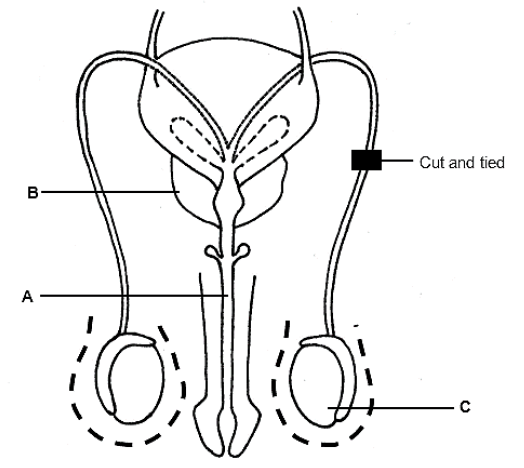
2.5.1 Identify part B. (1)
2.5.2 State ONE function of part A. (1)
2.5.3 Explain why part C moves away from the body on a very hot day. (3)
2.5.4 Explain why this procedure may fail to prevent pregnancy. (2)
[50]
QUESTION 3
3.1 A person had severe hearing loss which was caused by a damage to the ossicles and the inner ear. He underwent a cochlear implant. The cochlear implant partially restored hearing. When a person has a cochlear transplant, the sound waves are collected by the microphone and converted to a stimulus by the receiver and transmitter. The impulse is transmitted to the cochlea by an electrode.
The diagram below shows the structure of the ear with a cochlear implant.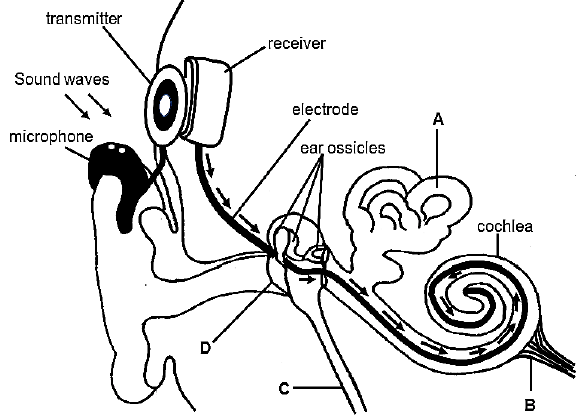
3.1.1 Identify part B. (1)
3.1.2 State ONE function of part C. (1)
3.1.3 Which part of the ear normally functions as the:
- Microphone (1)
- Receiver and transmitter (1)
3.1.4 Explain why a person may lose hearing ability if there is:
- Damage to the ossicles (3)
- A hole in part D (3)
3.1.5 Describe how part A and the brain together maintain balance. (4)
3.2 An investigation was conducted to determine the effect of auxins on direction of growth of the stem.
The procedure was done as follows:
- Two potted plants (1 and 2) of the same species and age were used
- The apical buds of both plants were removed by cutting at the same length along the stem
- The cut apical buds of both plants were placed on separate blocks of agar jelly for 2 hours
- One block of agar jelly was then placed on the right-hand top edge of the cut surface of pot plant 1 and the other block of agar jelly was then placed on the left-hand top edge of the pot plant 2, as shown in the diagram below
- Both pot plants were kept in a dark box for two weeks
- The direction of growth of the stem of both plants was observed at the end of this period
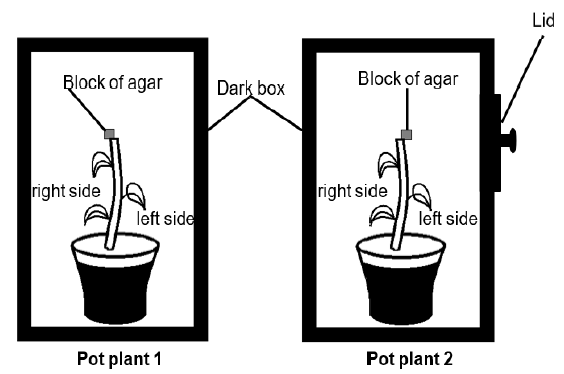
3.2.1 Give a reason why the apical buds were:
- Removed (1)
- Placed on the blocks of agar jelly for 2 hours (1)
3.2.2 Explain the results obtained for pot plant 1. (4)
3.2.3 Pot plant 2 was exposed to a unilateral light from the left-side by removing the lid on the box during this period. Explain the results that were obtained. (4)
3.2.4 Explain why fruit farmers periodically remove the apical buds from fruit trees. (2)
3.3 The graph below shows the homeostatic control of blood glucose in a healthy person.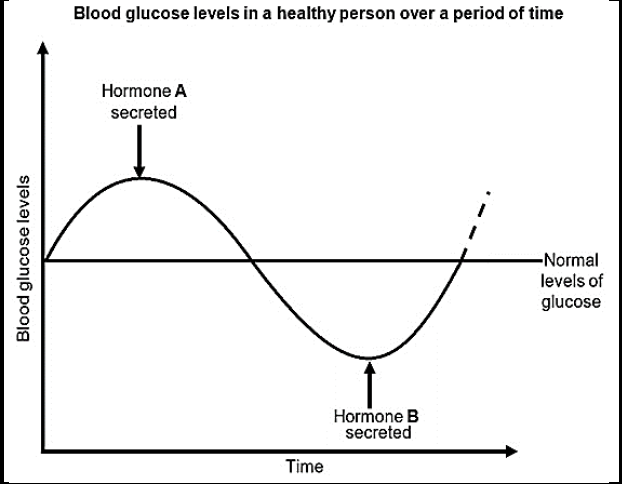
3.3.1 Identify:
- Hormone A (1)
- The gland that secretes hormone B (1)
3.3.2 Name the type of mechanism that controls the levels of hormones A and B. (1)
3.3.3 When a person is fasting whether for religious or health reasons, she/he does not eat food for a certain period. Explain the levels of hormone A in a person during fasting. (2)
3.3.4 Describe how hormone B functions to maintain normal levels of blood glucose. (4)
3.4 The diagram below represents the female reproductive system during pregnancy.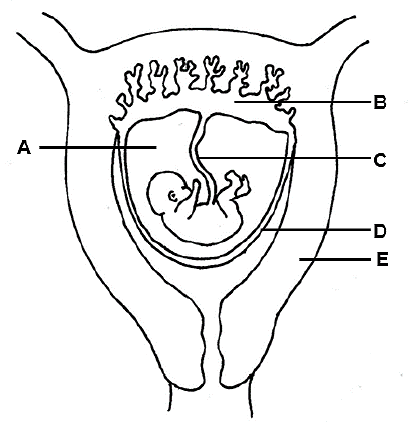
3.4.1 Identify:
- Fluid A (1)
- Extra embryonic membrane D (1)
3.4.2 Name the blood vessel in part C which transports oxygenated blood from the mother to the foetus. (1)
3.4.3 State TWO functions of part B. (2)
3.4.4 Describe the development of the zygote until part B is formed. (8)
3.4.5 Explain ONE structural suitability of part E to perform its function. (2) [50]
TOTAL SECTION B: 100
GRAND TOTAL: 150
